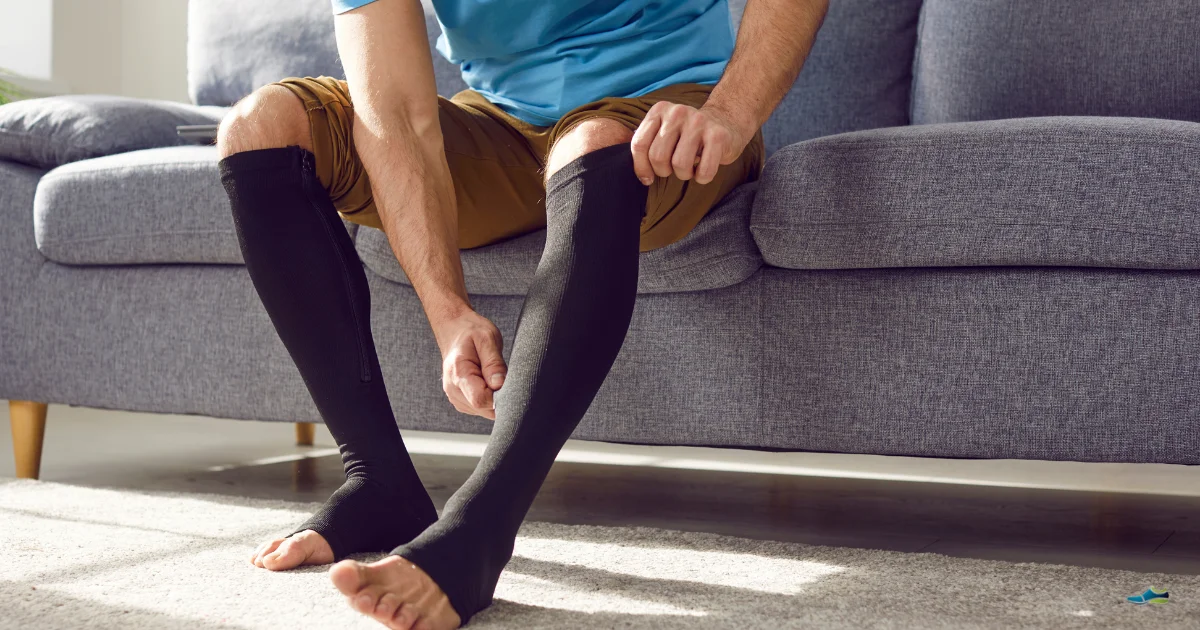If you’ve ever noticed ankle rings or heaviness after long shifts, you’ll understand why compression matters. Modern versions use comfort-grade pressure that supports without squeeze.
📌 At a Glance
- ✔️ Size compression by ankle & calf measurements — not shoe size.
- ✔️ Pick graduated pressure (e.g., 15–20 mmHg) for everyday support and swelling relief.
- ✔️ Non-binding cuffs + seamless toes prevent hotspots and pressure rings.
- ✔️ Compression should flow, not fight — if it bites or rolls, change size or brand.
If you’re new to compression, it helps to start with Socks & Tights for Swollen Feet (Oedema) — it shows the basics of gentle hold before moving into compression.
Why Compression Works (Without Feeling Medical)
Compression socks use graduated pressure — firmest at the ankle, easing up the leg — to help push blood and lymph fluid upwards.
The result? Less swelling, faster recovery, and that “light leg” feeling at the end of the day.
Think of it as a soft upward hug, not a straitjacket.
Old-school versions felt like bandages; new ones are designed for comfort first, using breathable yarns and wide cuffs that stay up without biting.
“If you’re curious about how this helps with pain specifically, see our guide on Compression Socks for Foot Pain.”
Donning Aids That Make Life Easier
- Rubber gloves or a silky donning sleeve: better grip, less tugging.
- Fold-then-roll technique: turn the sock to the heel, place toes, then roll up smoothly.
- Zipped versions: handy if bending is difficult after surgery.
- Replace every 3–6 months: daily wear reduces pressure over time.
The Right Level of Compression for Everyday Life
| Need | Recommended Level | Notes |
|---|---|---|
| Mild swelling / tired legs | 8–15 mmHg | Everyday light support. Feels like a snug sock. |
| Travel / long sitting or standing | 15–20 mmHg | Promotes circulation during flights or desk days. |
| Medical or severe swelling | 20 mmHg+ | Only under clinician guidance. |
For most readers, light compression is ideal. It’s the comfort zone between “too loose to help” and “too tight to tolerate.
Not everyone needs compression — thin, wide-fit socks can offer comfort without pressure.
Key Features to Look For
- Graduated pressure knit: tighter around the ankle, gradually easing up.
- Wide, stay-put cuff: holds without digging in.
- Flat or seamless toe: prevents ridge rub on sensitive joints or bunions.
- Soft, stretchable fibres: bamboo, merino, or microfibre for moisture control.
- Reinforced heel: improves fit and durability.
Avoid “shiny nylon” socks that trap sweat or one-size-fits-all pairs — compression must be precise.
Fit First: How to Size Properly
Compression socks live or die by fit. Too tight and they roll; too loose and they sag.
- Measure early morning and late afternoon.
Swelling changes numbers — take both readings. - Measure at three points: ankle (narrowest), calf (widest), and leg length (heel to knee).
- Match the size chart exactly.
Each brand varies — never guess by shoe size. - If between sizes: go larger for comfort unless prescribed otherwise.
- Check the cuff: you should slide a finger under it without a fight.
🧵 Need a guide? See our How To Measure Foot Width At Home post — same method, different tape measure.
Comfort Upgrades Most People Miss
- Moisture management: Bamboo or merino keeps legs cooler and drier.
- Colour & style: Compression no longer means clinical — look for ribbed, sport, or everyday neutrals.
- Knee vs calf length: Knee-highs are easiest to don; calf-highs work for everyday comfort.
- Zipped versions: Great if bending is difficult or post-surgery.
When (and When Not) to Wear Them
Do wear:
✅ During travel, long workdays, or after standing for hours.
✅ Post-surgery or recovery (if cleared by your clinician).
✅ When you notice swelling, tiredness or “heavy leg” fatigue.
Don’t wear:
🚫 Overnight, unless medically advised.
🚫 Over open wounds or inflamed skin.
🚫 If swelling is new, one-sided or painful — always seek medical review.
Caring for Compression Socks
- Wash inside-out on gentle, cool cycle.
- Skip fabric softener (it kills elasticity).
- Air-dry flat — no radiator or tumble dryer.
- Replace every 3–6 months if used daily — they lose pressure over time.
Related Reads
- Best Socks & Tights for Swollen Feet (Oedema)
- Hosiery for Wide Feet: The Complete Comfort Guide
- The Best Non-Binding and Diabetic Socks for Sensitive Feet
FAQs
8–15 or 15–20 mmHg for flying?
15–20 mmHg gives better travel support for most people; if in doubt or you have a condition, ask a clinician.
Why does the top roll down?
Usually the wrong size or leg ratio. Re-measure ankle/calf, match the brand’s chart exactly, and avoid one-size pairs.
Is overnight wear safe?
Only if prescribed. Most people should remove compression for sleep.
A: If you can’t slide a finger under the cuff, or you see deep marks or rolling, they’re too small or too strong — swap size or compression level.Disclaimer: Sue is not a clinician. Her posts reflect personal experience and research. Always follow your clinician’s advice for diagnosis or treatment.

